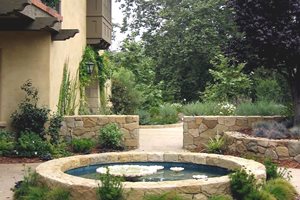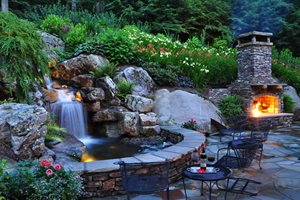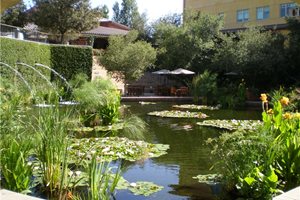Koi Pond Q&A
Neave Group Outdoor Solutions answers questions about koi pond design and maintenanceKoi ponds are one of the most beautiful additions you can make to your landscape, and koi are beautiful creatures. But even though they can't play fetch or roll over, fish are living things like any other pet that require more attention than your garden's other residents.
Are you ready for the care required of a koi pond? What do you need to know about these exotic fish and their environments before you install your pond?
We went to Mike Gulla, a landscape designer with Neave Group Outdoor Solutions in Wappingers Falls, New York, and asked him some questions about the design process used by the Neave Pools and Neave Aquatics divisions to create amazing pools and ponds that support a community of koi. Here's a look at some of his answers:
What materials are used to construct koi ponds?
There are no right or wrong options; it all depends on your design preference and budget. At Neave Group Outdoor Solutions, we install two types of koi ponds: liner ponds and gunite ponds. Both incorporate a skimmer, return lines and filtration system.
A liner koi pond is the most economical to install and the best option for a more naturalistic look and feel. We make a hole to the specified size, shape and depth, then insert a rubber pond liner much like one you would find in a swimming pool except a bit thicker and made of rubber rather than vinyl. Rocks around the edge keep the liner in place, then we fill in the rest with rocks to create the natural look most clients want.
A gunite koi pond is much more expensive and labor intensive; we create the hole then make the walls of the pond from lumber. We apply the gunite, a "spray" concrete, then add a layer of plaster or paint for the desired look. We can create a naturalistic look with gunite, but it's best in contemporary designs with straight lines and tight corners.
How large should a pond be to support koi?
One of the biggest mistakes you can make is building a koi pond that's too small. Standard pond sizing is 33 gallons of pond per 1 linear inch of koi fish, and the 6-inch fish you buy will be 24 inches long in a few years. (We recommend at least 1,500 gallons.)
You want your pond to be at least 2 feet deep to make sure your fish will survive the winter, but you may need up to 4 feet, depending on your site's microclimate - you want a pocket of water to remain unfrozen.
How much will a koi pond cost?
The sky's the limit, so to speak, but the most basic pond we can install - fish not included! - will probably cost about $7,500 from excavating the hole to filling the finished pond with water.
What type of regular maintenance is required for a koi pond and its population?
You must remove organic matter that could settle and decompose, and check and adjust the chemistry of the pond's water weekly so it stays balanced.
Why do you have to clean leaves and sticks out of a pond?
Organic matter starts to decompose when it enters a pond, releasing nitrates and other materials that diminish the water quality and effect the health of your fish. The decomposition process will also lower the amount of dissolved oxygen in the water.
Should you get a fountain or waterfall for a koi pond?
Water features aren't essential, but they're beneficial. They help to oxygenate the water and keep it moving, which helps prevent large algae blooms in your pond water. They're also beautiful and provide nice, ambient sound.
Why are some types of koi so expensive?
The price of koi depends on their size and breed. You can buy generic "baby" fish at a pet store for a few bucks, or you could spend a few thousand. Like any other "collector's item" the rarer the fish, the more expensive it will be.
How long do koi live?
There are stories of koi living up to 300 years, but we've never seen one. If properly taken care of, koi can live from 80 to 100 years.
How can you prevent predators from harming koi?
Design your pond with some naturalistic features, such as rock shelves and caves, where fish can hide. Water lilies and other plants also do wonders to hide fish from predators. The depth of your pond also plays an important role: a 4-foot-deep pond will prevent a land predator from reaching the bottom and capturing a fish.
Will koi bite my pets or children?
No! Koi do have teeth, but they're small and located in the back of the throat. Koi use them to crush crustaceans or other food - they could never use those teeth to bite you!
How can you protect koi during the winter months?
Koi go dormant and settle to the bottom of the pond during the winter, which is why it's doubly important to have a deep enough pond - you need that pocket of unfrozen water that extends to the surface of the pond to allow for gas exchange. A water feature can help to keep the water moving and unfrozen, but a pond heater also works.
What benefit do aquatic plants provide to the koi?
Aquatic plants can have both positive and negative effects. They offer fish a hiding spot, shade and oxygen, but they can also be difficult to grow and introduce parasites into the pond. Most aquatic plants also die back in the fall, which becomes a real mess to clean up. We find that a well-designed garden around the pond will add the same aesthetic beauty - minus all the headaches.
Neave Group Outdoor Solutions
Wappingers Falls, NY 12590

 Backyards
Backyards
 Front Yards
Front Yards









